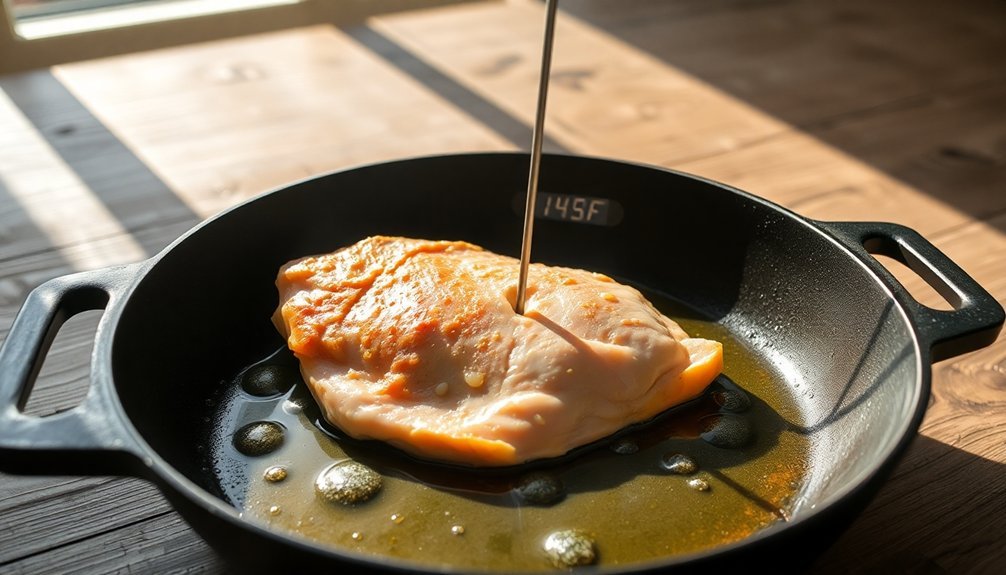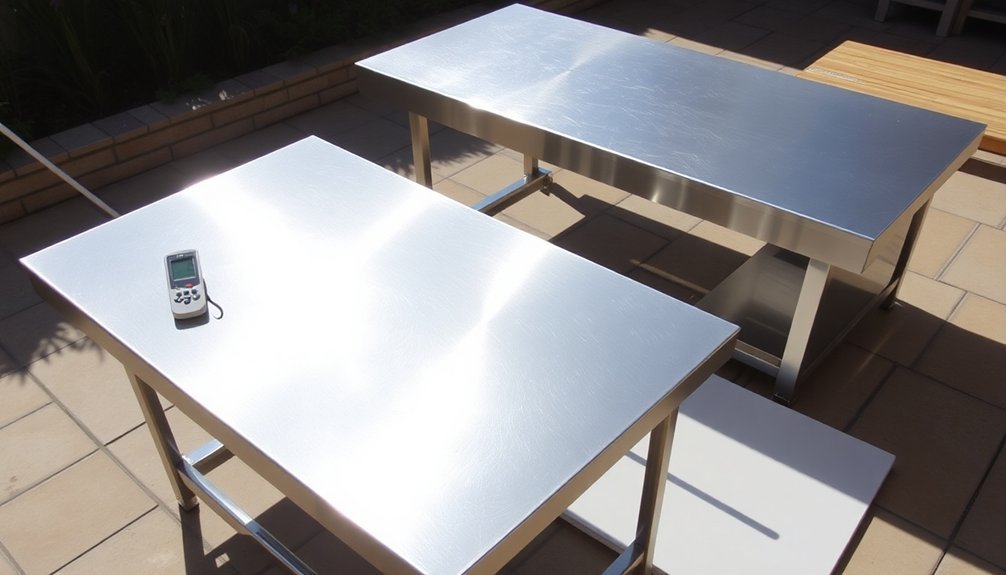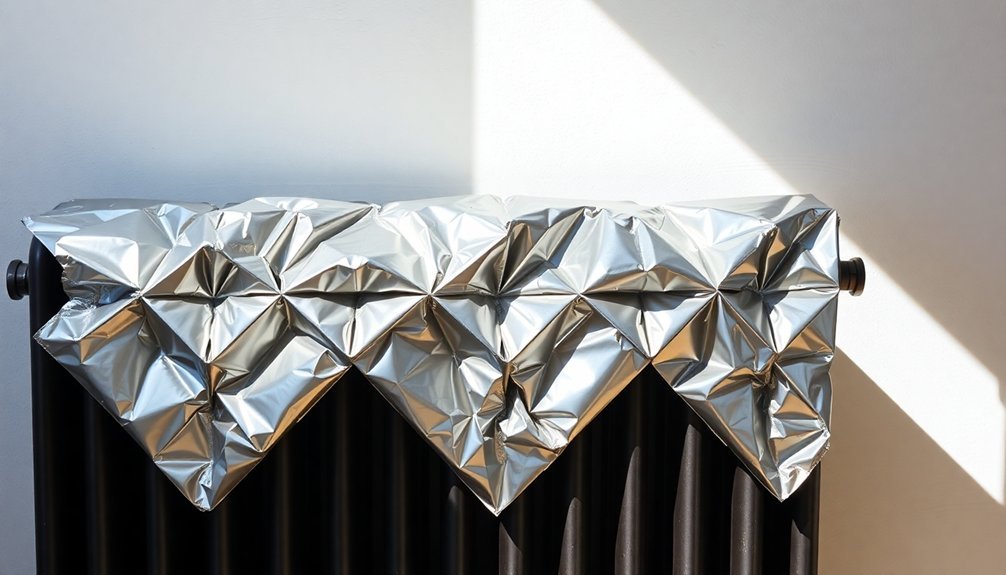You'll need to modify recipes for solar cooking because it operates quite differently from conventional ovens. Since solar cookers typically reach lower temperatures (200-300°F) and rely on sunlight, cooking times usually double, and moisture retention is higher. You'll want to reduce fat content, switch to liquid oils instead of solid fats, and plan your cooking schedule around peak sunlight hours (11 AM to 3 PM). Weather conditions like clouds and wind can affect temperature stability, requiring flexible timing adjustments. Understanding these key differences will help you master the unique art of solar cooking.
Understanding Solar Cooking Basics

While traditional cooking methods rely on electricity or gas, solar cooking harnesses the sun's energy to prepare delicious meals sustainably.
You'll need to adapt your cooking routine since solar ovens work best between 11:00 am and 3:00 pm when sunlight is most intense.
Your solar oven consists of essential components: a cooking chamber with clear plastic or glass covers to trap heat, reflective surfaces like aluminum foil to concentrate sunlight, and dark-colored materials to absorb heat.
You'll want to position your oven directly facing the sun and use a thermometer to monitor the internal temperature. Always maintain safe handling distances to avoid burns from hot surfaces.
Remember that cooking times typically double compared to conventional methods, but the slower process preserves more nutrients and enhances flavors.
Even on partly cloudy days, you can still achieve great results through slow cooking.
Temperature Control Challenges
Although solar ovens offer sustainable cooking solutions, mastering temperature control requires understanding several key challenges.
You'll need to account for environmental factors like wind and cloud cover that can affect your cooking temperature. Heat-retained baskets can help food continue cooking even when sunlight is temporarily blocked. While solar ovens maintain steadier temperatures than conventional ovens, especially at lower ranges, they're still dependent on sunlight availability and positioning.
Your location and the time of year will impact cooking effectiveness, with equatorial regions offering more consistent results.
You can regulate temperature by adjusting reflectors, repositioning the oven relative to the sun, or using lids strategically. The type of solar cooker you choose also matters – parabolic models can reach over 800°F, while box ovens typically max out at 300-400°F.
Understanding these variables helps you adapt recipes successfully for solar cooking.
Time Adjustments Matter

Successfully cooking with a solar oven requires understanding key time adjustments for peak results. You'll need to plan for longer cooking durations compared to traditional ovens, especially on partly cloudy days. Preheating your oven for 30 minutes and realigning it regularly guarantees maximum performance. Temperatures of 400°F are achievable on clear days when properly aligned.
| Time Factor | Impact on Your Cooking |
|---|---|
| Sun Position | Requires realignment every 30 minutes for consistent heat |
| Season | Winter needs steeper tilt; summer needs minimal adjustment |
| Weather | Clear days cook faster; clouds extend cooking time |
For unattended cooking, aim your oven where the sun will be strongest (1-2 PM). While intermittent clouds may slow cooking, they won't stop it completely. Remember to adjust cooking times based on seasonal changes and secure your oven on windy days to maintain steady temperatures.
Essential Equipment Setup
Setting up your solar oven requires specific equipment and careful attention to essential components.
You'll need a box or enclosure, preferably a cardboard pizza box or file storage container measuring 12" x 15" x 10". Line the interior with aluminum foil for maximum light reflection, and add black construction paper to absorb heat effectively.
For heat retention, you'll want to install proper insulation using newspaper or foam board. The rolled-up newspaper sheets provide excellent insulation between layers when using nested boxes. Cover the top with plastic wrap or Plexiglass to create a greenhouse effect, and secure it with clear tape.
Don't forget to create an adjustable reflective flap using aluminum duct tape as a hinge. Your cooking vessel should be black to absorb heat efficiently – you can paint a regular pot if needed. Place it in the center of your cooker on a stable support.
Recipe Modifications For Success

When adapting recipes for solar cooking, you'll need to make key changes to ingredients and timing for ideal results.
You should choose ingredients that cook well at lower temperatures (200-300°F) and adjust moisture levels since solar ovens retain more moisture than conventional ovens.
Your cooking schedule must align with peak sunlight hours, typically requiring 1.5-2 times longer than traditional cooking methods, with most dishes needing 2-4 hours of consistent sun exposure.
Key Ingredient Adjustments Needed
Modifying recipes for solar cooking requires specific ingredient adjustments to achieve ideal results.
You'll need to reduce fat content by substituting liquid oils for solid fats, using ¾ of the original amount. Replace half of your butter or oil with applesauce or prune purée, but remember to decrease your baking time by 25%.
When scaling recipes, use weight measurements for accuracy and multiply each ingredient by your conversion factor. If you're making 300 biscuits instead of 75, multiply everything by 4.
For sugar reduction, you can swap traditional sugar with alternatives like Stevia, using proper conversion rates. Consider splitting larger batches if your solar oven's space is limited.
For gluten-free baking, select appropriate flour substitutes while adjusting other ingredients to maintain proper texture.
Timing Changes For Sunlight
Successful solar baking depends heavily on adjusting your cooking times to match the sun's intensity throughout the day.
You'll need to monitor your oven's temperature continuously and make timing adjustments as sunlight conditions change.
Start your baking early when the sun is strongest, and be prepared to extend cooking times if clouds roll in or the sun's power wanes.
You'll get the best results during peak sunlight hours, but you can still bake successfully by rotating your loaves and adjusting the oven's focus as needed.
Different solar oven designs heat at varying rates, so preheat your oven before adding your dough or batter.
Remember that slow cooking often works best in solar ovens, and you'll want to maintain a minimum temperature of 225°F for proper baking results.
Monitoring Your Solar Cooking Progress
To achieve consistent results with solar cooking, proper monitoring of your cooking progress is essential. You'll need to use buffered probe sensors for accurate temperature readings and set up data loggers to track changes throughout the cooking process. Keep your sensors calibrated and collect data at appropriate intervals.
Watch how heat distributes across your solar oven by identifying hot spots and cold areas. You'll want to maintain ideal conditions by keeping reflective surfaces clean and rotating the cooker to face the sun directly.
Use dark cookware and thin metal baking dishes to maximize heat absorption. Pre-heat your oven for 15-20 minutes to improve efficiency. Track solar irradiance using apps or measurement tools to predict temperature fluctuations and adjust your cooking times as needed.
Frequently Asked Questions
Can Solar Ovens Be Used Effectively on Partly Cloudy Days?
Yes, you'll find solar ovens can work on partly cloudy days, though they'll cook slower. You'll need to use insulated ovens, adjust cooking times, and choose forgiving foods like beans and potatoes for best results.
How Do Seasonal Changes Affect Solar Oven Recipe Outcomes?
You'll need to adjust your recipes seasonally since winter brings longer cooking times and lower temperatures, while summer offers faster cooking. This affects food texture and doneness, requiring different timing and moisture levels.
What Materials Should Be Avoided When Cooking in Solar Ovens?
You'll want to avoid reflective materials like aluminum foil, shiny metals, and glass since they don't absorb heat well. Skip cardboard and unsealed wood too, as they're prone to moisture damage and poor insulation.
Does Food Cooked in Solar Ovens Retain More Nutrients?
Yes, you'll get higher nutrient retention in solar-cooked foods. Your meals will keep more vitamins, proteins, and minerals because solar ovens use lower temperatures and gentler cooking methods than conventional cooking appliances.
Can Solar Ovens Be Used to Sterilize Cooking Equipment?
Yes, you can sterilize cooking equipment in solar ovens. They'll reach temperatures above 160°C for hot air sterilization, which is sufficient when maintained for 60 minutes under direct sunlight with proper insulation.
In Summary
You'll find that adapting your recipes for solar cooking requires patience and practice. Watch your cooking temperatures closely, adjust your timing, and don't forget to position your equipment properly. Keep detailed notes of what works and what doesn't. While it takes extra effort to modify traditional recipes, you'll soon master the art of solar cooking and enjoy the sustainable benefits it brings to your kitchen.





Leave a Reply